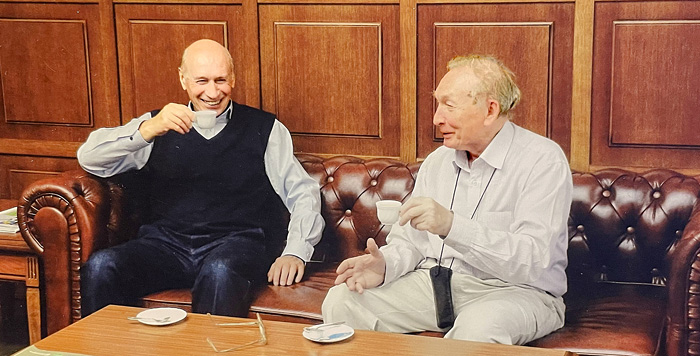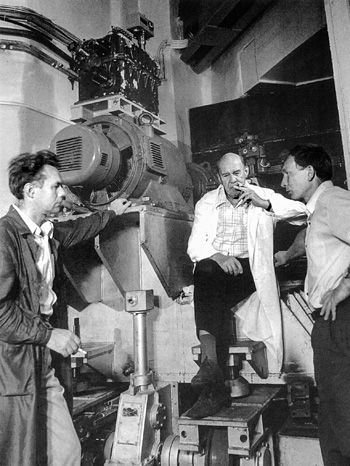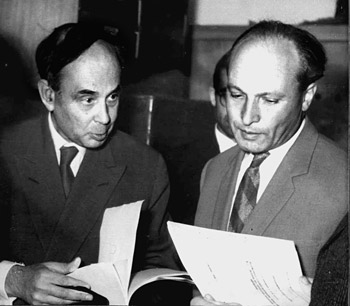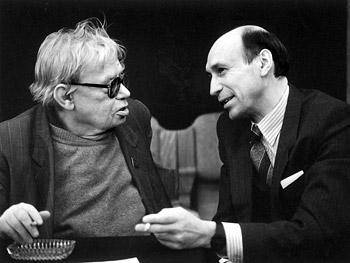
Electronic english version since 2022 |
The newspaper was founded in November 1957
| |
To the 40th anniversary of the IBR-2 reactor
Remembering history, thinking about the future
(Topic continued)
At the FLNP seminar on 22 June, 2022 (see No.24 of the weekly dated 30 June, 2022), reports were presented by V.L.Aksenov "On the scientific programme for the NEPTUNE reactor" and E.P.Shabalin "On the dynamics of pulsating reactors." Both reports had second titles, respectively: "Is there a future for pulsating reactors?" and "Dialectics of knowing the truth from one's own mistakes." Today, these second names have become even more relevant. Below, we are publishing the speakers' additions to their previous reports.
E.P.Shabalin. "Dialectics of learning the truth from one's own mistakes"
So few roads have been travelled
So many mistakes have been made.
S.Yesenin
The era of pulsating reactors is actually much longer than the 40 years that have passed since the meeting of the State Committee for putting the IBR-2 reactor into operation on 9 February, 1984. It is curious that on the day of the work of this Committee, the General Secretary of the Communist Party of the USSR Yury Andropov died. The author of this article sees the hand of fate here but he will talk about this another time.

V.L.Aksenov and E.P.Shabalin at PNPI.
And the history of pulsating reactors began in 1955 at one of the seminars at the Obninsk Physics and Energy Institute (FEI), where Dmitry Blokhintsev (then Director of IPPE) announced his idea about the possibility of developing a periodically pulsating research reactor. So, in 2025 it will be possible to celebrate the 70th anniversary of the era of pulsating reactors. Along this long path, two "pillar" roads were mastered - the actual IBR pulsed periodic reactors and subcritical systems with the multiplication of a source of neutrons from the target of an electron or proton accelerator, the so-called boosters. Choosing a path has always been difficult, like that of Okudzhava's "woman in the window": this one is beautiful, but in vain, this one, apparently, is serious.
 |
| V.D.Ananiev, D.I.Blokhintsev, E.P.Shabalin. |
There were more obstacles on the booster road than on the path of the pulsating reactor. Of the 60 calendar years of operation of basic neutron sources at FLNP JINR, 29 working years are accounted for by IBR-2 and IBR-2M and only 17 years are accounted for by the booster mode, mainly the operation of an improved version of the first IBR - IBR-30 with LUE-40 (1969-2001). The third time they tried to enter the booster path, developing a linear induction electron accelerator LIU-30 with a length of 200 meters that in combination with the IBR-2 reactor, promised to give short pulses of neutrons with an average power of 500 kW that would be 25 times higher than at IBR -30 with LUE-40.
However, already during the assembly of the first few inductors it became clear that it was fundamentally impossible to ensure the stability of a high-current electron beam. And IBR-2 "followed" the path of a pulsating reactor with a pulse duration of 200 ?s and a power of 2 MW.
It is interesting that the number 2 that appeared in the name of the IBR-2 reactor as the second after IBR, turned out to be "enchanted": ironically, the power of 2 MW, determined administratively by the selection committee on 9 February, 1984, due to technical reasons, became the real limit for the new reactor, although the design capacity of IBR-2 was set at 4 MW. This time, the staff was adequate and knew where to stop. But during the initial period of operation of IBR-30 (put into operation in 1969), many mistakes were made. It includes the ill-conceived design of the electron beam target, negligence in ensuring nuclear safety and the insufficient level of qualifications of the personnel that carried out the project. To work on the IBR-2 project (that began almost simultaneously with the IBR-30 project) in 1966 (and then, a pulsating reactor with a power of 10 MW was to be developed, that is, immediately to make a jump of more than 1000 times - IBR was still operating at three kilowatts) the most trained engineers and scientists were attracted that affected the quality of the IBR-30 project. And the accident on 11 July, 1972, when IBR-30 was operating in rare pulse mode (1 pulse every 2 seconds) with a faulty control system, can be considered quite probable. Then there was a melting of metallic plutonium in the reactor fuel rods and depressurization of one fuel rod - the one that had been bombarded for a long time using electrons reflected from the target. Fortunately, all the plutonium condensed in the form of oxides on the walls of the ventilation system and did not enter the external environment. During the construction and operation of IBR-2 and its modernized version (since 2011), nothing like this happened - a lesson from 1972.
After three decades of generally successful operation of IBR-2 and since 2011, of a modernized reactor (with a power of 1.5-2 MW, with an increased neutron flux in the extracted beams and with cold moderators of the original design), an issue on the further evolution of IBRs has arisen.
Firstly, the designated service life of the reactor building was approaching (2030s) and secondly, operating experience showed that there is a fundamental physical prohibition on operation above ~2-3 MW for pulsed plutonium reactors of the IBR-2 type. The fact is that for a long time the reason for the positive effect of reactivity when reducing sodium consumption that affects the stability of the IBR-2M reactor, remained unclear. And only with a deep analysis of the dynamics of high-power pulsating reactors, a group of physicists involved in the project of the future FLNP JINR reactor was able to formulate the features of pulsating reactors and show the inevitability of oscillatory instability in reactors of the IBR-2 type with plutonium loading.
 |
| I.M.Frank and F.L.Shapiro. |
And in conclusion, I would like to note once again that it was the development of the NEPTUNE project that discovered previously unknown features of pulsating reactors and allowed to understand and to explain the reasons for the "whims" of IBR-2M.
V.L.Aksenov. "Is there a future for pulsating reactors?"
One of the major achievements of JINR is undoubtedly a series of pulsating reactors that have no analogues in the world. In the mid-90s of the last century, there was a real threat that the IBR-2 reactor would be the last in this series. There were no funds for its operation and especially, for further development. We managed to overcome these difficulties and today, we have IBR-2M. But again, there is a danger that it will be the last. It seems useful to us to recall the history of that period with a projection to our days. I have no goal of writing a chronicle of the laboratory, so I apologize in advance to many participants in those events that will not be mentioned. The key points required for the development of a new reactor are formulated schematically (please, do not blame me for the not always successful formulations). So that the reasoning is not abstract, it is supported by specific examples.
 |
| N.N.Bogolyubov and V.L.Aksenov. |
Nowadays, physics is still rich in promising areas for neutrons. I will not repeat here everything that has been said and written more than once. I will note only as an example the possibility of establishing a factory of neutron-excess nuclides for nuclear physics and astrophysics at the NEPTUNE reactor. This scientific area intersects with the research of FLNR. It is important for the FLNP scientific programme to be part of the overall institute scientific programme.
E.P.Shabalin held the first seminar at FLNP with the idea of the NEPTUNE reactor in May 2015. The first official report to the governing scientific bodies of JINR on the scientific programme for the NEPTUNE reactor was presented in January 2017 at the PAC for Condensed Matter Physics. The development of a scientific justification for the project has started, but unfortunately, there is still no final document that could be submitted to government agencies.
Bright technical solutions for experimental complexes. In 1990-1992, together with physicists from PNPI RAS (Gatchina) and the Technical Research Centre of Finland, the first high-resolution Fourier diffractometer was developed using a pulsed neutron source. This diffractometer that allows measurements with a resolution almost limiting for neutron crystallography, destroyed the prejudice that existed in the scientific community regarding the limited capabilities of IBR-2 and brought it to the forefront of pulsed neutron sources in the world.
In a certain sense, an analogue today could be the complex of very cold and ultracold neutrons at the NEPTUNE reactor.
Personnel training is a difficult and lengthy process. The training of scientific personnel for the implementation of strategic plans for the development of neutron research at JINR is described in detail in the article in "JINR Communications" R3-2021-14.
The support of the scientific community is absolutely necessary, especially in modern life. In the 1990s, the State Programme of the Russian Federation for neutron research of matter was developed, in which FLNP played a leading role, Russia became a member of the European Neutron Scattering Association and finally, a Member State of the European Centre for Neutron Research - the Laue-Langevin Institute (Grenoble, France). Nowadays, all this may act differently, but it is obvious that active participation in national and international projects creates an atmosphere of mutual support at all levels and we need to work on this.
Cooperation with Rosatom. Cooperation with Rosatom State Corporation (formerly, the Ministry of Medium Machine Building, the Ministry of Atomic Energy) is of decisive significance in any actions with nuclear reactors. They are based on everything said above. My experience shows that none of these points can be excluded. Material for reactor fuel is allocated based on the significance of the scientific programme and government interest. There is a prejudice that Rosatom is only interested in applied research. This is wrong. Rosatom is interested in the transformation of a neutron into an antineutron or the scattering of a neutron on a neutron in the same way as the entire scientific community. Once again, I would like to express my gratitude to the ministers of those years for their constant support. L.D.Ryabev and V.N.Mikhailov helped to resolve issues with material for fuel for reactors in Dubna and Grenoble. The issue of modernizing the IBR-2 reactor was finally resolved by E.O.Adamov when he agreed to pay for all the work of the ministry's enterprises from Minatom funds. I emphasize that these decisions were made after multiple discussions at various Science and Technology Councils and with the strong support of the scientific community.
With the NEPTUNE reactor project, a start on this path was made at a joint meeting of the Presidium of the Science and Technology Council of Rosatom and JINR Directorate on 11 December, 2019, where the project aroused great interest and support. An agreement was signed between Rosatom and JINR. Unfortunately, this activity did not develop.
There is one more condition - the pace of decision-making and work production. I would also add a condition of determination. To begin with, it was necessary to at least determine the site for the future reactor complex and the possibilities of engineering and technical support. This is necessary even from a formal point of view when developing a preliminary design. For example, design work on the IBR-2 reactor had not yet been completed, but construction work was already underway at the selected site. And you don't need to tell us that times were different. As the poet said, "you don't choose times, you live and die in them."
Summary. Unfortunately, the above-mentioned conditions for the implementation of such large projects as NEPTUNE are not met. Note that these conditions are necessary for any new intense neutron source. Today, the pace is lost and the purpose is lost.
We have got lost in three pines: the NEPTUNE, IBR-4 reactors ("an improved," according to the authors, design of the IBR-2 reactor; in our opinion, this is an attempt to go forward with the head turned backward) and an alternative version of a compact neutron source based on an accelerator protons or deuterons. A classic situation of swan, crayfish and pike. It is obvious that we have reached a dead end. In a situation where it is not possible to move along the chosen path, you need to choose a different trajectory.
It seems logical to enter into cooperation with a partner more experienced in the construction of pulsed reactors. We successfully develop joint work with the Russian Federal Nuclear Centre VNIITF named after Academician E.I.Zababakhin (Snezhinsk) to study the issues of dynamic stability of the reactor NEPTUNE. FLNP physicists in the early 2000s carried out fundamental experiments on direct measurement of the neutron-neutron scattering cross section using one of the powerful pulsed reactors of the VNIITF. Scientists from this Institute have constantly expressed interest in further work. It seems promising to us to unite the efforts of the two Institutes in developing the NEPTUNE reactor. Perhaps, along this path we will be able to implement new ideas and new technologies in the continuation of a series of unique pulsating reactors and obtain record parameters for new physical research.